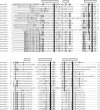Function and evolution of a gene family encoding odorant binding-like proteins in a social insect, the honey bee (Apis mellifera)
- PMID: 17065610
- PMCID: PMC1626642
- DOI: 10.1101/gr.5075706
Function and evolution of a gene family encoding odorant binding-like proteins in a social insect, the honey bee (Apis mellifera)
Abstract
The remarkable olfactory power of insect species is thought to be generated by a combinatorial action of two large protein families, G protein-coupled olfactory receptors (ORs) and odorant binding proteins (OBPs). In olfactory sensilla, OBPs deliver hydrophobic airborne molecules to ORs, but their expression in nonolfactory tissues suggests that they also may function as general carriers in other developmental and physiological processes. Here we used bioinformatic and experimental approaches to characterize the OBP-like gene family in a highly social insect, the Western honey bee. Comparison with other insects shows that the honey bee has the smallest set of these genes, consisting of only 21 OBPs. This number stands in stark contrast to the more than 70 OBPs in Anopheles gambiae and 51 in Drosophila melanogaster. In the honey bee as in the two dipterans, these genes are organized in clusters. We show that the evolution of their structure involved frequent intron losses. We describe a monophyletic subfamily of OBPs where the diversification of some amino acids appears to have been accelerated by positive selection. Expression profiling under a wide range of conditions shows that in the honey bee only nine OBPs are antenna-specific. The remaining genes are expressed either ubiquitously or are tightly regulated in specialized tissues or during development. These findings support the view that OBPs are not restricted to olfaction and are likely to be involved in broader physiological functions.
Figures




Similar articles
-
"Plus-C" odorant-binding protein genes in two Drosophila species and the malaria mosquito Anopheles gambiae.Gene. 2004 Feb 18;327(1):117-29. doi: 10.1016/j.gene.2003.11.007. Gene. 2004. PMID: 14960367
-
The Lepidoptera Odorant Binding Protein gene family: Gene gain and loss within the GOBP/PBP complex of moths and butterflies.Insect Biochem Mol Biol. 2015 Jul;62:142-53. doi: 10.1016/j.ibmb.2015.03.003. Epub 2015 Mar 14. Insect Biochem Mol Biol. 2015. PMID: 25784631
-
The odorant binding protein gene family from the genome of silkworm, Bombyx mori.BMC Genomics. 2009 Jul 23;10:332. doi: 10.1186/1471-2164-10-332. BMC Genomics. 2009. PMID: 19624863 Free PMC article.
-
A review of neurohormone GPCRs present in the fruitfly Drosophila melanogaster and the honey bee Apis mellifera.Prog Neurobiol. 2006 Sep;80(1):1-19. doi: 10.1016/j.pneurobio.2006.07.005. Prog Neurobiol. 2006. PMID: 17070981 Review.
-
An overview of odorant-binding protein functions in insect peripheral olfactory reception.Genet Mol Res. 2011 Dec 8;10(4):3056-69. doi: 10.4238/2011.December.8.2. Genet Mol Res. 2011. PMID: 22180039 Review.
Cited by
-
Insights from the Molecular modeling, docking analysis of illicit drugs and Bomb Compounds with Honey Bee Odorant Binding Proteins (OBPs).Bioinformation. 2018 May 31;14(5):219-231. doi: 10.6026/97320630014219. eCollection 2018. Bioinformation. 2018. PMID: 30108419 Free PMC article.
-
Antimicrobial peptide-like genes in Nasonia vitripennis: a genomic perspective.BMC Genomics. 2010 Mar 19;11:187. doi: 10.1186/1471-2164-11-187. BMC Genomics. 2010. PMID: 20302637 Free PMC article.
-
Characterization of antennal sensilla, larvae morphology and olfactory genes of Melipona scutellaris stingless bee.PLoS One. 2017 Apr 19;12(4):e0174857. doi: 10.1371/journal.pone.0174857. eCollection 2017. PLoS One. 2017. PMID: 28423045 Free PMC article.
-
Chemosensory Gene Families in Ectropis grisescens and Candidates for Detection of Type-II Sex Pheromones.Front Physiol. 2017 Nov 21;8:953. doi: 10.3389/fphys.2017.00953. eCollection 2017. Front Physiol. 2017. PMID: 29209233 Free PMC article.
-
Distinct Subfamilies of Odorant Binding Proteins in Locust (Orthoptera, Acrididae): Molecular Evolution, Structural Variation, and Sensilla-Specific Expression.Front Physiol. 2017 Sep 26;8:734. doi: 10.3389/fphys.2017.00734. eCollection 2017. Front Physiol. 2017. PMID: 29018357 Free PMC article.
References
-
- Altschul S., Madden T., Schaffer A., Zhang J., Zhang Z., Miller W., Lipman D., Madden T., Schaffer A., Zhang J., Zhang Z., Miller W., Lipman D., Schaffer A., Zhang J., Zhang Z., Miller W., Lipman D., Zhang J., Zhang Z., Miller W., Lipman D., Zhang Z., Miller W., Lipman D., Miller W., Lipman D., Lipman D. Gapped BLAST and PSI-BLAST: A new generation of protein database search programs. Nucleic Acids Res. 1997;25:3389–3402. - PMC - PubMed
-
- Bateman A., Coin L., Durbin R., Finn R., Hollich V., Griffiths-Jones S., Khanna A., Marshall M., Moxon S., Sonnhammer E., Coin L., Durbin R., Finn R., Hollich V., Griffiths-Jones S., Khanna A., Marshall M., Moxon S., Sonnhammer E., Durbin R., Finn R., Hollich V., Griffiths-Jones S., Khanna A., Marshall M., Moxon S., Sonnhammer E., Finn R., Hollich V., Griffiths-Jones S., Khanna A., Marshall M., Moxon S., Sonnhammer E., Hollich V., Griffiths-Jones S., Khanna A., Marshall M., Moxon S., Sonnhammer E., Griffiths-Jones S., Khanna A., Marshall M., Moxon S., Sonnhammer E., Khanna A., Marshall M., Moxon S., Sonnhammer E., Marshall M., Moxon S., Sonnhammer E., Moxon S., Sonnhammer E., Sonnhammer E., et al. The Pfam protein families database. Nucleic Acids Res. 2004;32:D138–D141. - PMC - PubMed
-
- Bendtsen J., Nielsen H., von Heijne G., Brunak S., Nielsen H., von Heijne G., Brunak S., von Heijne G., Brunak S., Brunak S. Improved prediction of signal peptides: SignalP 3.0. J. Mol. Biol. 2004;340:783–795. - PubMed
Publication types
MeSH terms
Substances
LinkOut - more resources
Full Text Sources
